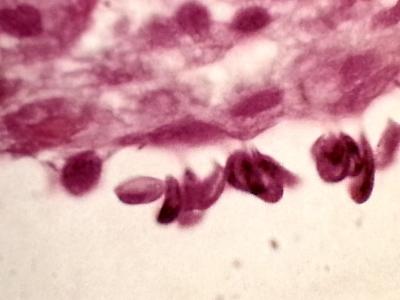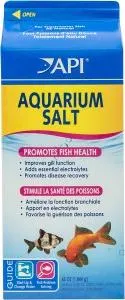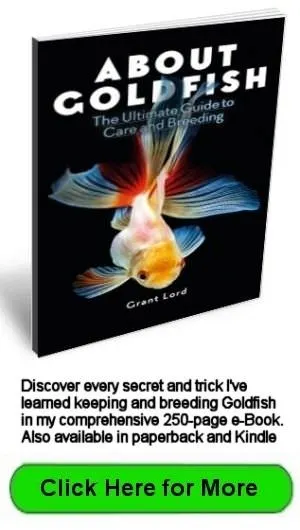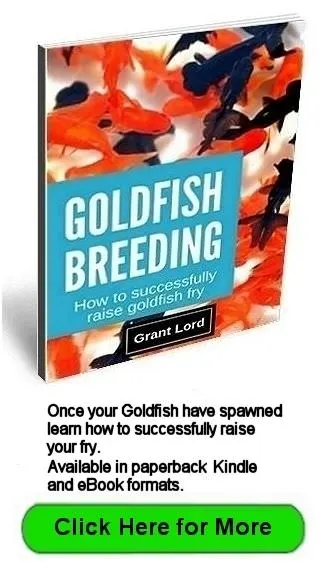- Home
- Disease Causes
- Common Goldfish Diseases
- Costia Disease
Costia Disease Treatment For Goldfish
Costia is a cold water single celled parasite that multiplies rapidly in cold water.
 Costia parasites attached to epidermal cells
Costia parasites attached to epidermal cellsThe correct Latin for Costia disease is Costia necatrix and it is classified as a protozoan flagellate, which means it has at least two long hair like appendages called flagella protruding from its cell. These are used for movement and feeding.
The parasite attaches itself to the skin and gill membrane burrowing into the top epidermal cells and feeding on their content. It can be present in small numbers without causing any harm.
A population explosion occurs when the Goldfish's immune system is weakened by its environment which is usually due to poor water quality.
The parasite may cover the whole fish or it may only affect patches. The level of infection depends on each fish's individual immune capability.
When it attacks the gills it presents the greatest danger to the fish.
Outbreaks often occur in spring when Goldfish are in a weakened state after winter hibernation.
Costia Disease Life cycle
Reproduction is by division and its speed depends on temperature. It reproduces rapidly at temperatures between 10oC (50oF) and 25oC (77oF) but does not survive at temperatures above 30oC (86oF).
The life cycle is completed in 10-12 hours at 25oC. At temperatures below 8oC (46oF) Costia transform into a cyst like state until conditions improve. Once they revert to their normal state they must find a host within a short time to survive.
If infected fish are removed from their aquarium or pond to a hospital tank for treatment, the gravel and plants can remain as without a host Costia die within 24 hours if the water temperature is above 15oC (59oF).
Symptoms
Costia disease can resemble the symptoms of trichodinosis, chilodotiasis and gyrodactylus and because the parasite is so small, 8-15 micrometers across, it is hard to confirm the diagnosis without taking scrapings and viewing them under a 300-400x microscope.
Goldfish displaying any or all of these symptoms should be suspected of having Costia:
- Clamped fins
- Loss of appetite
- Slime patches on body and fins
- Labored breathing
- Flashing
- Twitching of fins
- Red patches
- Fraying fins
- Mucus from the gills.
Treatment Options
With the need for accurate doses of medication due to their toxicity, and the volume differences between Imperial and US gallons, I will give dose levels in metric measurements.
Praziquantel - Medications containing this chemical can be used for fluke, worm (internal), and protozoan parasites, and Costia is a protozoan parasite.
It is non-toxic to fish, plants and biological filters
The dosage to use is usually 2 milligrams per liter or follow the manufacturers instructions.
Aquarium Salt - This is the next gentlest method of treatment as Goldfish can withstand a high level of salt in their water. If there is any evidence of gill damage (heavy breathing or fish staying at the surface), salt is a safe option.
The amount of salt should start at 0.3% (3-4 grams per liter or a tablespoon per gallon). This should normally be enough for a cure but there is evidence that salt resistant strains are starting to appear.
To be confident that all of the parasites have gone, bring the salt content up to 0.6% by adding another 3 grams per liter or tablespoon per gallon after 12 hours, and if your fish are still feeding and don't appear distressed at this level of salinity, add another 3 grams per liter after another 12 hours, bringing the total salt content up to 0.9%.
If the parasite still proves persistent at 0.6%, already weakened fish may not tolerate a 0.9% salinity level and Praziquantel will be a better option.
Keep your fish in this solution for at least 72 hours. By this time they should be feeding well, with all their fins being held away from the body and no sign of twitching or flashing.
Start doing daily 25% water changes to slowly bring the salinity level down.
Formalin - Formalin is another treatment for salt resistant Costia.
Use 50 PPM (parts per million) Formalin (2 milliliters per 40 liters) for two hours then make a 50% water change.
Repeat this sequence twice more. An additional benefit is flukes will also be killed using this treatment.
Hydrogen peroxide - If you have larger fish with red or white patches on their bodies and you suspect it is Costia, you can use 3% hydrogen peroxide to dab the areas with a cotton bud soaked in the solution. This allows healing to commence earlier.
You will still need to use one of the other treatments to mop up the remaining parasites.
Heat Treatment - This parasite multiplies extremely rapidly at temperatures between 25oC (77oF) and 28oC (82oF) but doesn't tolerate temperatures above 30oC (86oF).
If your fish are already at higher temperatures, this is a safer option than using chemicals.
I would still have some Aquarium salt in the water, around 0.3%. Make sure there is good water circulation as oxygen levels are low at these higher temperatures.
There is a theory that Costia may inhabit the cloaca or anal pore of fish which may protect them from chemical treatments. This may explain why there is sometimes a recurrence of the disease. Using the high water temperature treatment method would stop this from happening.
Costia Can Survive Drying Out
Costia encyst when environmental conditions become unfavorable. They lose most of their water content and form a cyst membrane that serves as a protective covering. By doing this they can tolerate drying out.
Equipment such as aquariums, nets, filters and hoses exposed to the parasite can re-spread the disease even if they have been dried out.
The parasite dies within 24 hours without a host so disinfect equipment immediately after use using hot water, and leave aquariums set up without any aquatic life, including snails, for a day or two.
After two days I would still strip down the aquarium and disinfect everything with hot water just to be sure.
Top of Costia Disease Treatment page






